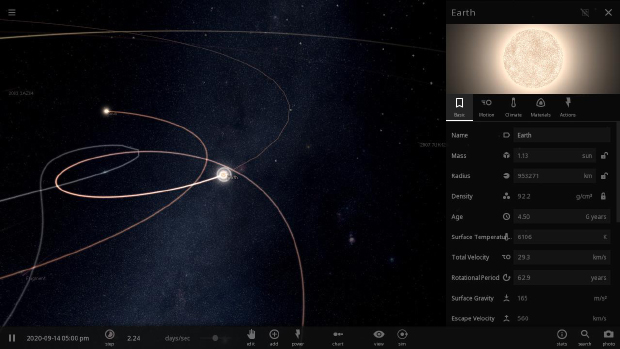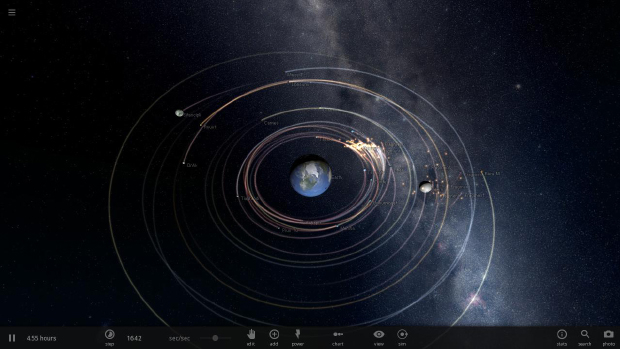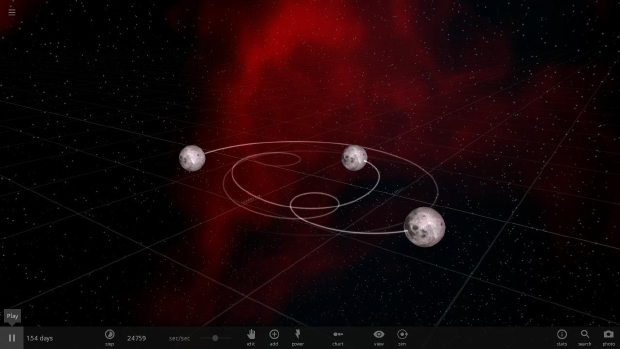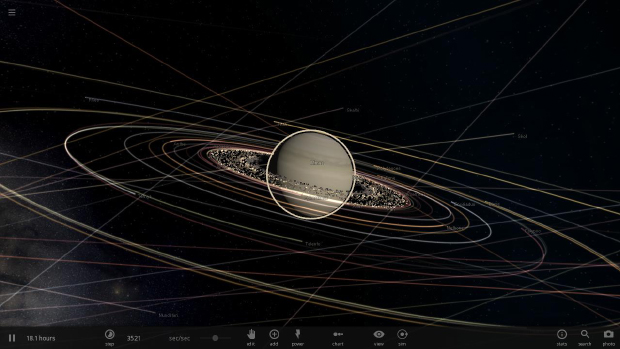Premature Evaluation: Universe Sandbox 2
Solar, so good
Each week Marsh Davies orbits the supermassive blackhole that is Early Access and comes back with any stories he can find or gets shredded to subatomic spaghetti as he tumbles towards a point of infinite mass. This week he has become death, destroyer of worlds, and really quite a lot of moons as well, in Universe Sandbox 2. Otherwise known as Universe Sandbox², if you’re the kind of terrible prick who insists on using Character Map to enforce your brand. Anyway, the game’s great.
Inexplicably, Earth begins to grow. Hour by hour, it just keeps putting on mass. The scientists can’t explain it. Where is all the weight coming from? It’s as if some malevolent god had discovered Earth’s settings panel and decided to yank up the mass slider, just to see what happens. What happens is that, as Earth reaches a mass equivalent to Jupiter - 318 times that of Earth’s normal mass - the orbits of other planets begin to distort alarmingly. Venus gets a bit too interested, spiralling after Earth then twisting away at the last moment, like an unsuccessful pickpocket. The planet swells further, its own rotation slowing and slowing. Somewhere, I like to think, some semi-sentient hemorrhoid is honking about the myth of global enbiggenment just before being crushed to death by his own skull, which has become 35 times heavier than it was earlier that day.
Moments later, Earth completes its transformation from happy blue-green habitation to gigantic blue-grey death vortex. When it hits a mass equivalent to 42 Jupiters, it begins to ignite, stripes of brilliant orange encircling the gloomy swirling globe. Venus is gravity-slapped clear out of the solar system. Earth’s surface temperature now exceeds 500 degrees centigrade. At 74.5 Jupiters, it becomes a molten glowing ball, and soon thereafter an actual sun, albeit a tenth of the mass of the system’s normal sun - which is nonetheless swerving through space as the two bodies waltz around one another. Mercury plunges directly into the heart of Hot Earth and is consumed utterly. Mars decides Venus had the right idea, and legs it. But it’s not nearly fast enough: the two suns can’t resist one another, conjoining violently to make a sweet fiery love that rapidly engulfs the core planets of the solar system, gobbling up the the Kuiper belt and spreading turquoise tendrils into the interstellar dark that lies beyond.
I did that. I can do loads of other things too, and the inhabitants of Earth will rarely thank me for them. What happens when you fire a teapot which is ten times larger than the sun through the heart of the solar system? Or if hapless scientists inadvertently create a black hole on Mars? What does the collision of two galaxies look like? Or the Earth being hit by a tennis ball the size of our own moon? Universe Sandbox 2 gives you the tools to run all such simulations in a level of depth which is at least superficially convincing and informative. It’s easy to use, beautifully tutorialised, and hugely fascinating. In fact, the sort of anarchic fun described above takes second place to the simple examination of how our solar system actually works. You can click on any body within it and bring up a panel which will allow you to modify everything from its semi-major axis to its argument of periapsis and a whole host of other things that don’t sound like erectile dysfunctions. But before I even tweaked a single albedo slider, I spent a good few hours just zipping about the solar system using the ample number of visualisation tools to examine the relative orbits and velocities of the bodies therein.
What particularly fascinated me were the dwarf planets and minor planets. Call me a pig-ignorant bumguff barely deserving of life, but I hadn’t really been aware of the number of these that exist in our own solar system. Open up the simulation entitled Solar System All Possible Dwarf Planets and you’ll see. Our solar system, which I tend to lazily think of as a sun, eight planets, the try-hard Pluto, and a handful of moons and rocks, has so many other bodies of significant mass that my PC begins to creak to a standstill. Luckily, the regular Solar System simulation picks a few of the more interesting ones to visualise. Take cold, lonely Sedna for isntance - a suspected dwarf planet that orbits the sun well beyond any other known body of similar mass. It’s hugely elliptical orbit means that it’s currently enjoying summery temperatures of -243 °C, wandering through the darkness some three times the distance Neptune is from the Sun. I can use the Universe Sandbox 2 to watch as it completes its fly-by, the data and my crude observation suggesting that it’ll come as close as it has been in 10428 years some time in 2065, before winding its way back out to a distance around 30 times further than Neptune.
If you want to get a sense of how far that is, you can use the “pulse” tool to track a burst of light from the sun, emitted in a ring, as it expands - at light-speed of course. It takes 4.1 hours to reach Neptune. 5.1 days to reach Sedna at its furthest point. Though I imagine it won’t take the edge off the chill - 10° above absolute zero. To get an idea of Sedna’s scale, you can switch to graph mode, which lines up each of the objects in the simulation side-by-side, reordering them based on whichever statistic you desire. Sedna’s a diddy 520 km in radius, a third of the size of our moon. You can map orbits and colour them to indicate velocity, acceleration or mass. There’s an entire page of simulations you can load designed only to produce pretty spirographic trails as bodies arc around one another. You can watch climate simulations, as the years etch away at the polar caps. You can examine the exact trajectory of NASA’s interplanetary paparazzi, the New Horizons, as it passes by Pluto. You can discover a binary star system which would explain the weather in Game of Thrones. Or you can spawn a simulation of Earth with 5000 moons and watch as your computer splutters.
There are loads of simulations of varying levels of absurdity and scale, and other pre-sets to toy with. The tutorials are clear, concise and elegantly demonstrate to you a few of the universe’s marvels: how to create a pulsar, for instance. But you can always create your own solar system from scratch, placing bodies and assigning trajectories as you like. And then, possibly, detonating it all afterwards. Call me a dumb ape-like genetic garbage golem, but my main problem with the game is currently that I know too little about the universe to know what would be interesting for me to then find out using Universe Sandbox 2: a few more tutorials of this kind, to give me a guided tour of basic astrophysics, would be welcome. Alt-tabbing to Wikipedia is no great hardship either, but I would nonetheless love some general writing about the things you are observing, to give you a sense of why they are remarkable - even though much of what is fascinating is evident from the simulation itself.
One thing that is not evident is how time advancement works: you can speed up and slow down the simulation, although, call me a grotesque idiot who should probably choke on his own tongue, but the tool for doing so is entirely incomprehensible to me. It seems to have some sort of sporadically effectual throttle and a text entry box that ignores whatever you put in it. This is a significant hindrance, as the solar system simulation maxed out at 3 years/per second, which meant it would have taken an hour before Sedna reached its furthest point from the Sun and I could note its effective surface temperature. Instead I edited the simulation, dragged Sedna from the warm bosom of the solar system and plonked it in the abyssal depths where the most distant point of its orbit was predicted to lie. I got the readout, but, having disrupted its orbit, Sedna now lost interest in our neighbourhood and wandered off into the night.
There are a few minor bugs (I once had Mercury headbutt the Sun out of existence) and not all the features are seemingly yet implemented (what does the habitable zone toggle do?), but the devs anticipate another whole year in Early Access, during which time more bespoke community-suggested simulations, like the New Horizons fly-by, will be added, as well as life simulation, terraforming, missions, space tethers and more. Call me a thicko dipshit who wallows in the slurry of his own stupidity, but even in its current form, Universe Sandbox 2 has done as much to lift me from my colossal ignorance as any game I’ve recently played. No mean feat.
Universe Sandbox 2 is available from Steam for £19, and directly from the developer, too. I played the version with the Build ID number 746711 on 27/08/2015.













